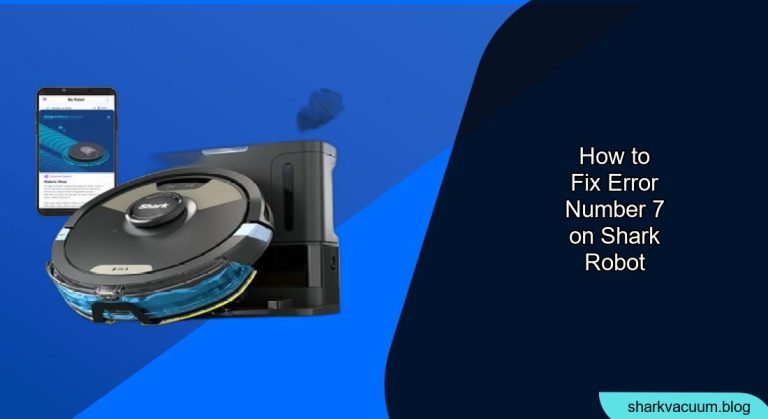Experiencing an error with your Shark robot vacuum can be frustrating. Error 7 typically indicates a problem with one of the robot’s wheels. This guide will walk you through the steps to diagnose and resolve this issue, keeping your Shark robot cleaning smoothly.
Understanding Error 7
Error 7 on a Shark robot vacuum usually points to an issue with either the left or right wheel. This could be due to obstructions, mechanical failure, or sensor problems. Addressing this promptly can prevent further damage and maintain your robot’s performance.
Table of Contents
Troubleshooting Error 7: A Step-by-Step Guide
Here’s how to troubleshoot and potentially fix error 7 on your Shark robot vacuum:
1. Initial Assessment and Preparation
Before diving into the fix, ensure your robot is powered off and disconnected from the charging dock. This prevents any accidental starts or electrical issues during the troubleshooting process.
Tools/Materials:
- Soft cloth or brush
- Small screwdriver (Phillips head)
- Can of compressed air (optional)
2. Cleaning the Wheels
Obstructions are the most common cause of Error 7. Hair, debris, and string can easily get tangled around the wheels, restricting their movement.
Steps:
- Inspect the Wheels: Turn the robot over and visually inspect both wheels. Look for any visible obstructions like hair, string, or debris wrapped around the axles.
- Remove Debris: Use your fingers or a small tool to carefully remove any tangled debris. A small screwdriver can help dislodge stubborn obstructions.
- Clean the Wheel Housing: Use a soft cloth or brush to clean the area around the wheels and inside the wheel housing. This removes any hidden dirt or dust that may be causing friction.
- Test the Wheels: Manually rotate each wheel to ensure they spin freely. If a wheel is still difficult to turn, repeat the cleaning process.
3. Checking the Cliff Sensors
Sometimes, dirty or malfunctioning cliff sensors can trigger false error codes. These sensors prevent the robot from falling down stairs.
Steps:
- Locate the Cliff Sensors: These are usually located on the underside of the robot, near the edges.
- Clean the Sensors: Use a dry, soft cloth to gently wipe the sensors clean. Dust or debris on these sensors can interfere with their operation.
- Test the Robot: Place the robot on the floor and see if the error persists.
4. Resetting the Robot
A simple reset can sometimes clear temporary software glitches that might be causing the error.
Steps:
- Locate the Reset Button: The reset button is typically found on the bottom or side of the robot. Check your user manual for the exact location.
- Press and Hold: Use a pen or paperclip to press and hold the reset button for 10-15 seconds.
- Restart the Robot: Release the button and turn the robot back on. See if the error has cleared.
5. Inspecting the Wheel Motor
If cleaning and resetting don’t work, the problem might be with the wheel motor itself. This step requires a bit more technical skill.
Steps:
- Access the Wheel Motor: This usually involves removing a few screws on the underside of the robot to access the wheel assembly. Note: Consult your robot’s service manual or online videos for specific disassembly instructions.
- Check the Wiring: Inspect the wiring connected to the wheel motor for any loose connections or damage. Reconnect any loose wires.
- Test the Motor: If you have a multimeter, you can test the motor for continuity. If the motor shows no continuity, it may need to be replaced. Note: This step requires knowledge of basic electrical testing.
6. Contacting Shark Support
If you’ve tried all the above steps and the error persists, it’s time to contact Shark customer support. There might be a more complex issue that requires professional attention.
Steps:
- Gather Information: Have your robot’s model number and purchase date ready.
- Contact Support: Visit the SharkClean website or call their customer service line.
- Explain the Issue: Clearly explain the troubleshooting steps you’ve already taken.
Practical Tips and Considerations
- Regular Maintenance: Regularly clean the wheels and sensors to prevent future errors.
- Avoid Problem Areas: Identify areas in your home that tend to cause obstructions and try to block them off.
- Software Updates: Keep your robot’s software updated to the latest version to fix any known bugs.
Troubleshooting Guide
| Problem | Possible Solution |
|---|---|
| Wheels not spinning freely | Remove tangled hair and debris, clean wheel housing. |
| Error persists after cleaning wheels | Reset the robot, check cliff sensors, inspect wheel motor. |
| Robot stops frequently with Error 7 | Ensure the robot is operating on a flat surface, check for software updates, contact customer support if the issue continues. |
| Wheel motor makes unusual noises | Inspect the motor for damage or wear, consider replacing the motor if necessary. |
| Robot unable to navigate properly | Clean cliff sensors, ensure the robot’s path is clear of obstacles, check for interference from reflective surfaces or dark flooring. |
Alternatives and Variations
If you’re unable to fix the error yourself, consider these alternatives:
- Professional Repair: Take your robot to a qualified repair technician.
- Warranty Claim: If your robot is still under warranty, contact Shark to arrange a repair or replacement.
- Replacement: If the cost of repair is too high, consider purchasing a new robot vacuum.
FAQ Section
What does error 7 mean on a Shark robot vacuum?
Error 7 on a Shark robot vacuum typically indicates an issue with one or both of the robot’s wheels. This could be due to obstructions like hair or debris, a malfunctioning wheel motor, or a problem with the wheel sensors. Addressing this error promptly can help prevent further damage and ensure your robot continues to clean effectively.
How often should I clean the wheels of my Shark robot vacuum to prevent error 7?
To prevent error 7, it’s recommended to clean the wheels of your Shark robot vacuum at least once a week, or more frequently if you have pets or a lot of debris on your floors. Regular cleaning helps remove hair, string, and other obstructions that can get tangled around the wheels and cause the error.
Can I use WD-40 to lubricate the wheels of my Shark robot vacuum if they are stiff?
No, it is not recommended to use WD-40 or other similar lubricants on the wheels of your Shark robot vacuum. These lubricants can attract more dust and debris, which can worsen the problem and potentially damage the wheel motors. Instead, focus on thoroughly cleaning the wheels and the surrounding area to remove any obstructions.
What if resetting my Shark robot vacuum doesn’t fix error 7?
If resetting your Shark robot vacuum doesn’t fix error 7, there may be a more significant mechanical or electrical issue. In this case, further troubleshooting steps include inspecting the wheel motors and checking the cliff sensors. If the problem persists, contacting Shark customer support or seeking professional repair services is advisable.
Are there any specific models of Shark robot vacuums that are more prone to error 7?
While error 7 can occur in various Shark robot vacuum models, certain models with more intricate wheel designs or weaker motors may be more prone to this issue. Checking online forums and reviews for your specific model can provide insights into common problems and solutions. Regularly maintaining your robot and promptly addressing any signs of wheel issues can help prevent error 7.
How do cliff sensors affect the occurrence of error 7 on Shark robot vacuums?
Cliff sensors, located on the bottom of the Shark robot vacuum, prevent the robot from falling off edges. If these sensors are dirty or malfunctioning, they can send incorrect signals, leading the robot to behave erratically or trigger error codes like error 7. Cleaning the cliff sensors regularly ensures accurate detection and helps prevent false error messages.
Tips, Warnings, and Best Practices
- Safety First: Always power off and disconnect the robot before performing any maintenance.
- Gentle Cleaning: Avoid using excessive force when cleaning the wheels or sensors.
- Regular Checks: Make it a habit to inspect the wheels and sensors regularly to catch potential issues early.
Conclusion
Fixing Error 7 on your Shark robot vacuum involves a systematic approach to identifying and resolving the underlying issue. By following this guide, you can often resolve the problem yourself, saving time and money. Regular maintenance and prompt attention to any issues will keep your robot running smoothly and efficiently. If all else fails, don’t hesitate to contact Shark support for further assistance.







